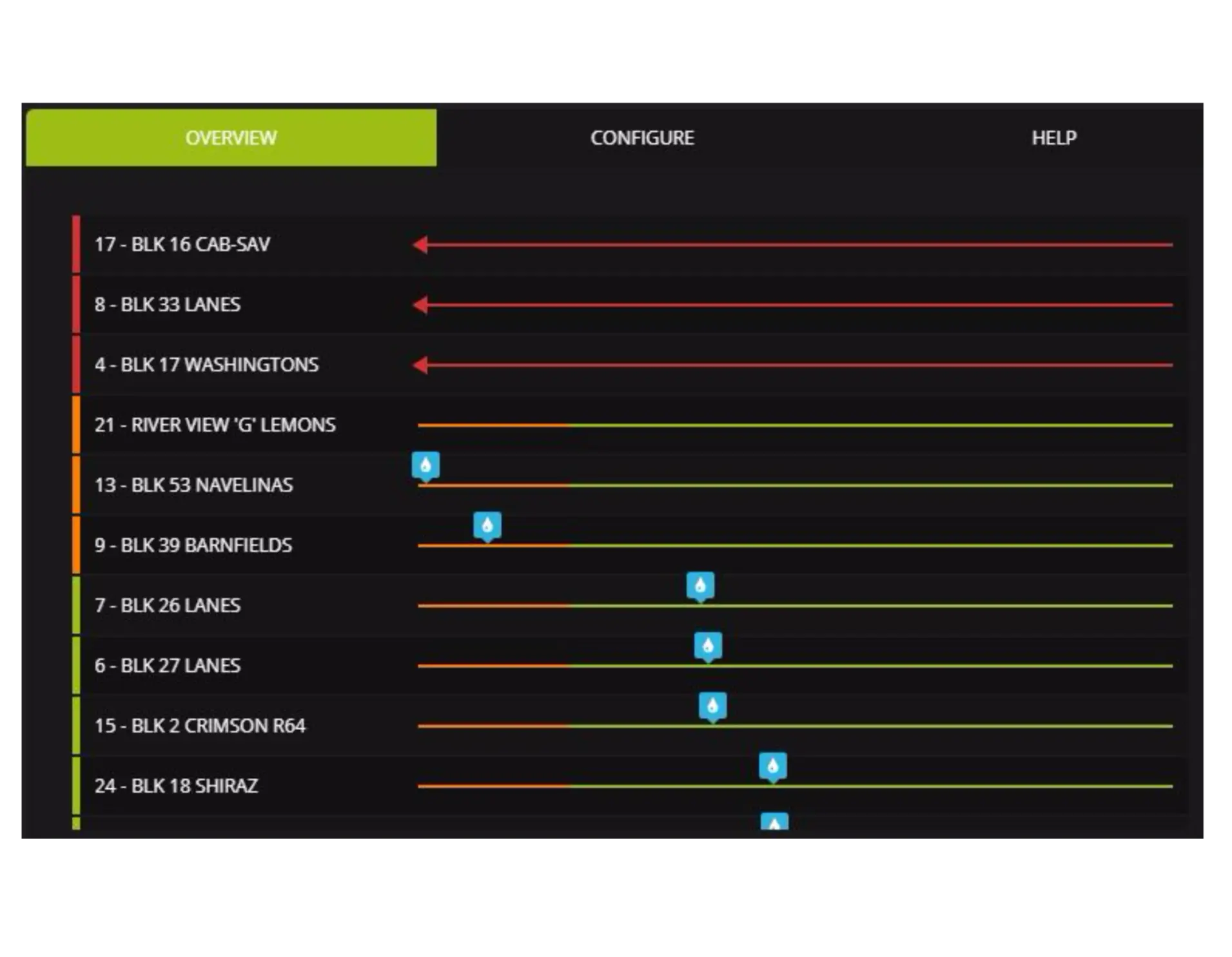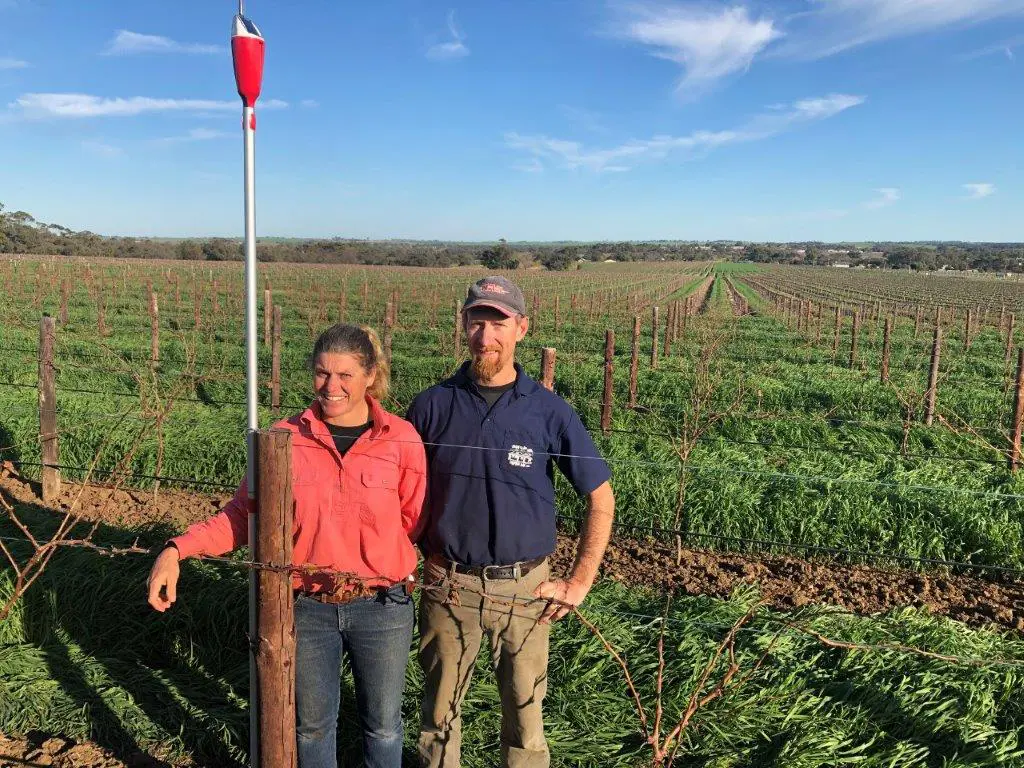The 2020 Barossa Viticulturalists of the Year has been awarded to Fiona and Daniel Habermann, the owner operators at Habermann Höhe. With 50 hectares of carefully managed vines between Bethany and Vine Vale, the Habermann's are both quick to identify water management as of constant focus.
“Last year was the driest we've had according to our records” Daniel says, “and so far, this year is shaping up to be worse”. In dry years particularly, the pair are grateful for previous investments they've made in minimizing risks to water supply.
“We've got vines over six different soil types, from black cracking biscay to sand over clay. We grow wine grapes for six different wineries, with each parcel of fruit grown specifically for its end use. We grow Shiraz, Cabernet, Grenache, Tempranillo and Riesling, all of which we water from three different water sources, surface water, bore water and BIL water (Barossa Infrastructure Limited, a supplementary irrigation water distribution system),” Fiona says.
Those three water sources are inter-connected such that every vine on their property can be watered from any individual source of water at any time. The focus on securing water availability for their vines is only half of that story though. The other half is in carefully targeting irrigation to achieve pre-determined quality outcomes for each parcel of fruit, regardless of what the weather throws at them.
As Daniel explains “historically, we'd give our vines probably one big drink per month because that was all we could get done in a rotation. Nowadays, because we know exactly what water is going on, and when, every block gets watered exactly as it needs to.”
“We target very specific moisture levels to achieve certain grades of fruit. Essentially, each variety is grown for a particular winery customer to reflect exactly what it is they are targeting.” Daniel explains. Though with five grape varieties planted over six soil types to achieve targets specified by six wineries, the complexity of fine-tuning irrigation schedules to achieve the desired outcomes is immediately apparent.
That's where Green Brain comes in. It's been designed to show the current soil moisture levels of each irrigation block in a single view, to give an immediate snapshot of the entire vineyard. Then, whenever required, each block can be further interrogated to understand how water is moving through the soil profile, and how much of a reserve remains in the deeper sub-soils. The other obvious benefit of Green Brain is its portability - “the fact it's on the phone is gold!” says Daniel.
Though it's not so much about using less water - it can't be. “How much water the vines need in a season is completely dependent on winter rainfall and where we start the season in terms of soil moisture storage through the deeper sub-soils. And with hotter, drier summers that usage increases even more.”

Most importantly, Green Brain gives the Habermann's the certainty required to confidently navigate through each season, regardless of how it shapes up.
“With every drop of water being so precious, we need to use it as wisely as we possibly can.”
It's hard to argue against the Habermann's obvious commitment to excellence and consistency. They place a big emphasis on a thorough check of their entire irrigation system every Spring.
As Fiona says, “in typically the start of September, we'll go through every single row, every dripper will get looked at, we'll check the grommets and risers, look for where the foxes and Kangaroos have chewed the dripline. That generally takes a solid week.”
Doing so gives them both the certainty that the water they apply is being delivered as uniformly as possible across each vineyard block.
The value to both Fiona and Daniel of using Green Brain and knowing exactly where they stand in terms of soil moisture throughout the growing season, is essential.
“The importance of having our finger on the pulse, and watering at those important times. What we could potentially lose is just too great a risk” Daniel concludes.
The Habermann's originally made the leap to Green Brain in 2013, when they decided to upgrade their old manual logging system to an automatic Plexus monitoring system from MEA that measured gypsum blocks. That gave them real-time access to soil moisture information, available on their phone, whenever they wanted it. The time savings were immediate.
“That little manual logger took probably 5 hours a week to go around to all the sites, manually log, then put that back on the computer to get an idea of what was going on with soil moisture levels”.

The simplicity of interpreting gypsum block readings was of immediate appeal. And they had certainly done the job initially. Despite the lower rainfall and hotter summers, Habermann Höhe is still considered very water efficient - in the 2019-20 season, they were able to grow some premium grape varieties using just 0.9 ML/Ha, through a combination of rootstock selection, good soil structure and careful management. Daniel suggests “that's purely record-keeping, and knowing exactly what's going on.”
But the uncertainty at the very driest end of the gypsum block range prompted the Habermann's to upgrade their Green Brain system to ensure they could precisely manage water availability to their vines coming into harvest.
As Daniel outlines, “for this upcoming season, we've gone from gypsum blocks to EnviroPro probes instead because we were finding the gypsum blocks in the drier seasons were just getting too unreliable.”
The problem was worst in the harder soils where understanding the exact level of 'dry' was becoming important.
"We were getting to a dry point, of 500 kPa, and then we just couldn't wet them up and they were useless.”
The back to back dry years are having other impacts too. Water sources are shifting from fresh surface water from streamflow to a mix of bore water and BIL water, and managing salinity becomes the next issue to consider. What hasn't been seen for a few years, are the big flushing rains through winter that pushed accumulated salt down past the vines root zone. So shandying bore water with other water sources in the dam is the best they can do to keep the salt load to a minimum while they wait for better winter rains.
That makes using water as efficiently as possible even more critical, as unneeded irrigation adds more to the salt load, but under-watering places an extra level of stress on the vines. Again, that's where Green Brain comes in. Knowing how deep each irrigation infiltrates into the soil profile, and knowing when the vines will need another drink, become the essential tools required to track the ideal pathway between these competing factors.
Given the hotter drier summers and the need to start irrigating earlier to offset low winter rainfall, using water efficiently is a no-brainer.
“Every drop is gold and we need to treat it as such to get through”.
